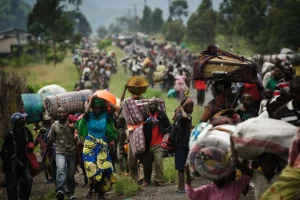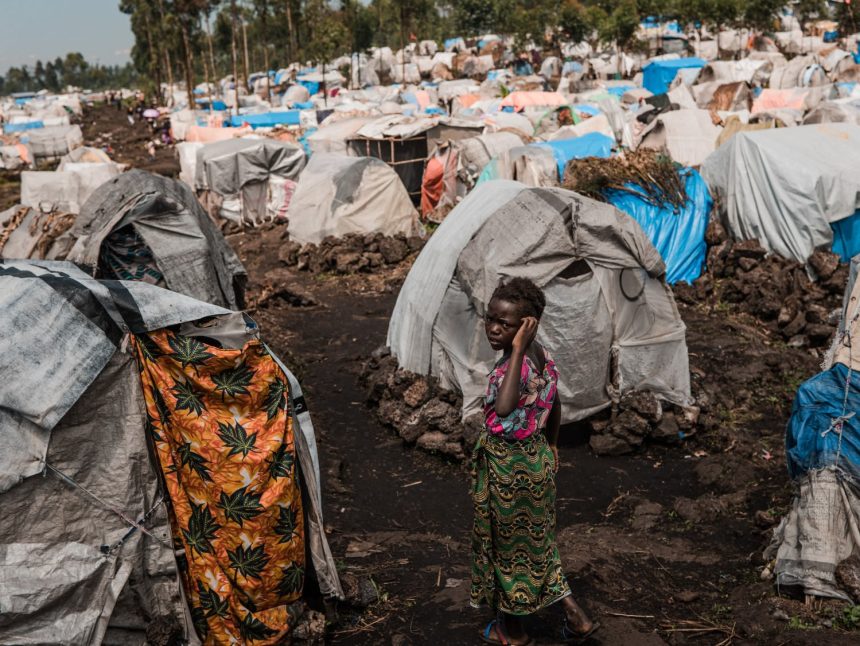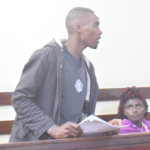The Democratic Republic of Congo (DRC; the Congo) experienced a spike in violence in the latter months of 2023. Clashes involving militant groups over territory and natural resources, extrajudicial killings by security forces, political violence, and rising tensions with neighboring countries have contributed to high rates of civilian casualties and displacement.
Following years of widespread protests against peacekeeping forces, which have been accused of abusing civilians and labeled ineffective by officials, Kinshasa ordered international and regional contingents to leave the country. The drawdown of foreign forces is planned to coincide with a highly contested presidential election in December 2023. Violence in the Congo’s resource-rich eastern provinces also shows no signs of slowing as the conflict dynamics change rapidly. In October, the UN envoy to the Great Lakes region raised alarms about a potential direct DRC-Rwanda confrontation, citing a military buildup on the longtime adversaries’ shared border. In addition to reports of mounting civilian casualties in eastern Congo, the UN declared that the number of internally displaced people had reached a record high of 6.9 million as fighting renders a growing part of the country unsafe for civilians.
Since 1996, conflict in eastern DRC has led to approximately six million deaths. The First Congo War (1996–1997) began in the wake of the 1994 Rwandan Genocide, during which ethnic Hutu extremists killed an estimated one million minority ethnic Tutsis and moderate Hutus in Rwanda (DRC’s neighbor to the east). During and following the genocide, nearly two million Hutu refugees crossed the Congolese border, mostly settling in refugee camps in the North Kivu and South Kivu provinces. A small subset of those Rwandans who entered DRC were Hutu extremists who began organizing militias within the Congo. Pressure intensified as Tutsi militias organized against the Hutu groups and as foreign powers began taking sides.
Following the Rwandan Patriotic Front’s (RPF) victory against the genocidal Rwandan government, the new Tutsi-led government began its involvement in DRC (then known as The Republic of Zaire). Rwandan troops, under the leadership of President Paul Kagame, and Congo-based Tutsi militias with Rwandan backing launched an invasion of Zaire, which was ruled at the time by Dictator Mobutu Sese Seko. Kigali justified both efforts by arguing that Hutu groups in eastern DRC were still a threat to their Tutsi population and that the Mobutu regime was harboring Hutu extremists who had fled across the border.
Rwanda waged the First Congo War against Zaire with the help of other African states (most significantly Uganda, but also Angola and Burundi) who had their own security concerns related to Mobutu’s support of rebel groups across the continent. The Rwandan coalition’s invasion was coordinated with the help of Zaire’s then-opposition leader Laurent Kabila. Thousands died; some casualties were former Hutu militants and members of armed groups, but many were refugees and non-combatant Congolese in North and South Kivu, in eastern DRC. Methods of warfare were brutal, especially those employed by Rwandan soldiers and Tutsi groups. The Kabila-Kagame coalition won the First Congo War in 1997 when Mobutu fled Kinshasa. Kabila was installed as president of Zaire and changed the country’s name back to The Democratic Republic of Congo.
In 1998, the Second Congo War broke out following the deterioration of relations between Kigali and Kinshasa. In an attempt to diminish the impression that Rwanda held undue influence over the Congolese government, Kabila denied claims that Rwanda had been responsible for winning the war and placing him in power. Kabila also began removing ethnic Tutsis from his government and took measures to weaken Rwanda’s military presence in eastern DRC. By the late 1990s, it was becoming clear to the world that targeted campaigns against Hutu populations during the First Congo War (mostly led by Kagame’s army) amounted to war crimes, a growing international consensus that reflected poorly on the fledgling Kabila regime.
In a reversal of alliances, Kabila ordered all foreign troops out of the Congo and allowed Hutu armed groups to organize at the border once again. Rwanda responded by invading in 1998. Kigali’s stated aim was to create a zone in the DRC-Rwanda borderlands controlled by its own troops in order to create more distance from Hutu groups in eastern DRC. Congolese forces supported by Angola (which also reversed alliances following the ascent of Laurent Kabila), Namibia, and Zimbabwe fought the Rwandan, Ugandan, and Burundi militaries, as well as various rebel groups supported by Kigali and Kampala. Amidst the chaos of war, Laurent Kabila was assassinated in a 2001 coup attempt planned by his own aides and guards. Those involved were imprisoned and Kabila’s son, Joseph Kabila, took power.
The Second Congo War was formally brought to a close under the junior Kabila in 2002, and while estimates vary greatly, the death toll of the Second Congo War and the associated humanitarian disaster may have reached over three million people by 2004.
Between 2002 and 2003, Rwanda, Uganda, and DRC began implementing a set of peace agreements that authorized a transitional government in Kinshasa led by Joseph Kabila. Despite these agreements, the establishment of truth and reconciliation commissions, and the presence of a renewed UN peacekeeping force, unrest and clashes persisted in eastern DRC. Joseph Kabila was formally inaugurated following a long-awaited popular election in 2006.
One of the most prominent rebel groups to emerge in the early 2000s was known as the March 23 Movement (M23), made up primarily of ethnic Tutsis. Between 2012 and 2013, M23 became an undeniable force in eastern DRC, and Kinshasa accused Kigali of backing the group. In 2013, The UN Security Council authorized a rare offensive brigade under the mandate of the UN Organization Stabilization Mission in the DRC (MONUSCO) to support the Congolese army in its fight against M23. MONUSCO was effective in its support of the Congolese army, and M23 called off its initial campaign in 2013. Evidence of Rwanda’s support for M23 caused lasting damage to the Kigali-Kinshasa relationship.
Other flashpoints have arisen over the past two decades in states on the Congo-Rwanda border, such as Ituri, most often involving ethnic and militant groups with contestations going back to the Congo Wars. The 21st century brought one more complication to peace efforts in the Democratic Republic of Congo: the proliferation of mining operations. DRC is home to some of the world’s largest reserves of metals and rare earth minerals used to produce advanced electronics. As the world has become more reliant than ever on cobalt, copper, zinc, and other minerals, local and external groups have become more incentivized to get involved in the Congolese conflict.
Félix Tshisekedi was declared the winner of DRC’s December 2018 elections and was inaugurated in January 2019. The transfer of power from President Joseph Kabila marked the first peaceful transfer of power in the DRC’s history. However, the 2018 election results have since been questioned, and some polling data indicates that a different candidate, Martin Fayulu, may have won. Upon his inauguration, Tshisekedi inherited a number of crises, including outbreaks of Ebola and ongoing violence in eastern DRC.
The abundance of natural resources—especially precious minerals—found in Congolese soil has globalized the conflict in eastern DRC. While U.S. companies once owned vast cobalt mines in the Congo, most were sold to Chinese companies during the Barack Obama and Donald Trump administrations. Chinese companies connected to Beijing now control the majority of foreign-owned cobalt, uranium, and copper mines in DRC, and the Congolese army has been repeatedly deployed to mining sites in eastern DRC to protect Chinese assets. The Joe Biden administration has acknowledged that China’s virtual monopoly in DRC’s mining industry plays a significant role in boosting China’s comparative advantage in the energy and technology arenas and is a hindrance to U.S. clean energy aspirations.
China is involved in Congo’s internal conflict as well as its economy: the Congolese government is fighting M23 rebels with the help of Chinese drones and weaponry, and Uganda has purchased Chinese arms to carry out military operations within DRC’s borders. The deals China negotiated with Congolese leadership, especially during the Joseph Kabila regime, have helped Chinese firms secure unprecedented access to metals that allow them to mass produce electronics and clean energy technologies. The Beijing-Kinshasa relationship came under international scrutiny leading up to President Kabila’s resignation in 2019 when evidence emerged that Chinese capital—intended for infrastructure investment as repayment for mining rights—was being funneled to Joseph Kabila and his associates.
China and DRC’s complex, multi-layered economic and military relationship has resulted in limited access to the Congo’s vital resources and profits for other countries and the Congolese people themselves. China’s presence in resource-rich eastern DRC is not without its risks, however; in September 2023, Chinese nationals were among the casualties of a militant group’s deadly robbery of a mining company convoy. Additionally, a U.S. congressional human rights commission heard testimony in July 2022 regarding the use of child labor and other illegal practices in Congolese mines, allegedly including those owned and operated by Chinese companies. While the United States does maintain a relationship with DRC, the trade relationship is minimized by U.S. restrictions on imports from conflict-affected states and bans on importing “conflict minerals,” which are resources such as tin and gold mined for the profit of armed groups in the Congo and neighboring countries.
In 2022, renewed tensions mounted between DRC and Rwanda. M23 rebels resurfaced after five years of inactivity and had gained control of large parts of the North Kivu province by July 2023. Kinshasa accused Kigali of funding and supporting M23’s resurgence (an accusation supported by the African Union, European Union, and the United States). In return, Kigali accused Kinshasa of once again supporting Hutu extremist militias and increased its military presence inside the Congo. Rwanda and Uganda—and militias with their support—have financial stakes in Congolese mines (though they are not always legitimate). In October, UN Special Envoy to the Great Lakes Region Xia Huang warned that tensions between the two countries could lead to an open military confrontation, expressing his concerns about “the military strengthening in both countries, the absence of direct high-level dialogue, and the persistence of hate speech.”
Repeated attempts to reach a lasting ceasefire between M23 and the Congolese government have been unsuccessful, and violence continues to come in waves. Casualties remain on the rise as armed groups attack displacement camps, civilians in the DRC and abroad, and self-defense groups. In May, the South African Development Community (SADC) agreed to deploy troops to eastern Congo to assist UN forces ahead of the December 2023 elections. However, a month later, the UN announced a planned withdrawal of the largely unpopular [PDF] MOUSCO peacekeeping mission, a decision the United States called premature. The poor reputation of the UN mission has led to violent unrest and extrajudicial killings of anti-MONUSCO protestors by Congolese security forces in Goma. UN officials have acknowledged that the drawdown of MONUSCO and other forces poses the risk of a security vacuum amid a deteriorating security situation in Ituri and North Kivu.
In addition to the threat of M23, the Congolese military and residents of eastern DRC continue to contend with increasing attacks by the Islamic State-affiliated Allied Democratic Forces (ADF) and other groups. DRC’s relations with its other neighbors remain charged, including those with Burundi and Uganda.
DRC is home to nearly 7 million people who have been internally displaced due to the threat of violence and atrocities, extreme poverty, and mining expansion. The displaced population is in urgent need of security support, medical aid, and other humanitarian aid. Approximately one million Congolese nationals are seeking refuge beyond the Congo’s borders. DRC is holding national elections on December 20, 2023. In the three months leading up to the election, candidates have been attacked by the president and even jailed, and the political opposition is split between two dozen candidates. International monitoring groups have raised alarms about the corrupt practices of the Congo’s electoral commission and the potential for political violence in and beyond Kinshasa, which would compound the conflict in the eastern provinces and further increase displacement just as foreign troops withdraw from DRC.



